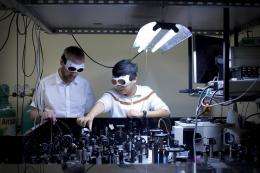Water Motions Revealed (w/ Video)

(PhysOrg.com) -- Gaze into a glass of water, and you're unlikely to see much more than your own reflection. But gaze a little deeper using a microscope -- or, better yet, a series of laser pulses and detectors -- and you'll see an intricate molecular dance. As water sits, seemingly calm, the hydrogen bonds between water molecules are continually breaking and forming, with each molecule switching dance partners a hundred billion times a second.
"We've known for quite a while that the hydrogen bonds change constantly, but the details were still fuzzy," said Kelly Gaffney, a researcher at the joint SLAC-Stanford PULSE Institute for Ultrafast Energy Science. "In recent simulations, others have found that the switch from one bond to another happens very quickly, and that the angle between the hydrogen atom bonds changes by 60 or 70 degrees. But it's so hard to simulate the complex nature of water that it was important to check this prediction experimentally."
Now, in collaboration with Stanford physics graduate student Minbiao Ji and Stockholm University chemical physicist Michael Odelius, Gaffney has conducted intricate experiments showing that the molecules do indeed act as simulations predict.
In their experiments, the researchers studied not pure water but a mix of water and a type of salt called sodium perchlorate. In this solution, each water molecule's two chemical bonds (connecting its two hydrogen atoms to its oxygen atom) interacted with other water or perchlorate molecules, forming hydrogen bonds. These distinct hydrogen bonds differ slightly in strength depending on whether they connect a water molecule with another water molecule or with a perchlorate molecule. They also each change the vibrational strength of the water molecule's chemical bond differently, enabling researchers to distinguish the two types of hydrogen bond. By sending carefully timed laser pulses into the water-perchlorate mixture, Ji and Gaffney were able to compare these initial vibrations with the vibrations a bit later, measuring how long it took for the molecules to switch dance partners. The answer? About once every six picoseconds, or 160 billion times a second.
"That's fast," Gaffney said.
The researchers were also able to determine how the angle of the bond changed from moment to moment because laser light is polarized, with an intrinsic extra "directionality" at right angles to the light rays' direction of travel. As a result, the laser pulse preferentially excites molecules with bonds parallel to the laser light's polarization, allowing the researchers to distinguish between bonds oriented in this direction and those oriented in all other directions. By looking at the orientation of water molecules that have switched dance partners from another water to a perchlorate molecule, they could determine how far and how fast a water molecule rotates when it exchanges hydrogen bonds.
"We found that the hydrogen bond breaks and reforms with an angular jump of about 50 degrees," Gaffney said. "And that's about what simulations performed by Michael Odelius suggested."
The method used by Gaffney and his team to measure the bond lifetime and angle worked well for water and perchlorate, but is not possible with pure water; when all water molecules form the same hydrogen bonds, there is no way for the researchers to tell when they have switched partners. Fortunately, Gaffney said, all simulations seem to imply that the results found for salt water apply to pure water and a variety of aqueous solutions.
"This is exciting work," Ji said. "To really understand water, the stuff that makes up more than half our bodies, we need to understand how these molecules move in a microscopic field. But it's only with the recent development of ultrafast lasers that we've been able to measure the time scale of these small molecules."
Provided by SLAC National Accelerator Laboratory


















